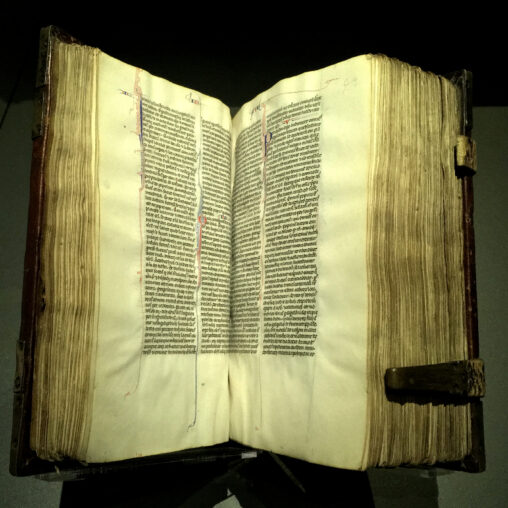In order to determine why the Bible itself can be trusted, one must first question how any historical source is tested for its veracity – put simply, the Bible must be held to the same standards as all other historical documents; such standards can include accurate preservation of the source over time and corroboration of claims through multiplicity of sources and accompanying physical evidence. Biblical credibility thus stems first from the efficacy of its preservation over time compounded with the sheer quantity of biblical manuscripts from the Old and New Testaments, and second, from the existence of archeological evidence in support of its claims.
On the former criterion, the preservation of the Bible, (and in particular, the New Testament), it can be definitively concluded that it is alone the most recorded and recovered piece of ancient literary history. As Daniel Wallace, American professor of New Testament Studies at Dallas Theological Seminary writes, “In comparison with the remaining manuscripts of any other ancient Greek or Latin literature, the New Testament suffers from an embarrassment of riches. It is almost incomprehensible to think about this disparity…the New Testament has no peer.”1 Explained numerically, Wallace continues, “It would be safe to say that we have altogether about 20,000 handwritten manuscripts of the New Testament…But if we compare all the manuscripts of a particular classical author, regardless of when they were written, the total would still average at least less than 20 and probably less than a dozen.”2 This latter claim is no exaggeration; if other ancient sources such as Cornelius Publius Tacitus’ The Annals, a compendium on Imperial Roman history, are bibliographically compared to the New Testament, we find that where the latter possesses 20,000 copies to justify the accuracy of its transmission, only two of Tactitus’ manuscripts have survived3. Thus, as Kurt Aland, a 20th century German theologian and Biblical scholar, states, “It is precisely the overwhelming mass of the New Testament textual tradition … which provides an assurance of certainty in establishing the original text.”4
Yet, in spite of the obvious lack of bibliographical confirmation for The Annals, nearly all past and contemporary historians trust in the reliability of Tacitus’ recordings. This is because historical fact is not determined by word alone but additionally by corresponding physical evidence. Therefore, even though Tacitus’ claims may not be accompanied by thousands of manuscripts ranging from various continents in the same way that the New Testament does, his works have proven themselves to be accurate in their description of the Roman Empire through the wealth of archeological evidence we now possess today.
It is at this point therefore, that the archeological evidence in support of the Old and New Testaments must be analyzed in order to further demonstrate the reliability of the Bible. In the late 18th century, William Mitchel Ramsay, a notable classical scholar, archeologist, and determined atheist, set out to expose the seeming historical inaccuracies of the Book of Acts and the epistles of Paul the Apostle. Contrary to his expectations, Ramsay’s findings in Greece, Anatolia, and Turkey led him to completely disprove his initial thesis. As he later came to claim “(There are) reasons for placing the author of Acts among the historians of the first rank.”5 Ramsay’s conclusions didn’t merely alter his perspective on the historicity of the Bible however; they eventually led him to become a devoted Christian as well.
Evidence for events of the Old Testament are no less numerous or robust. Beginning with the 1947 recovery of the Dead Sea Scrolls, all the books of the Old Testament (with the exception of Esther), were found and determined to be 1000 years older than the previously believed earliest copy of the Old Testament from 900 AD. When this copy was compared with the scrolls, they were nearly identical in their recordings, thus proving that the Old Testament has not been substantially corrupted or altered since its first manuscripts were produced but rather has been accurately transmitted through the centuries.
Thus, in spite of persistent claims from anti-Christian opposition that the Bible has been corrupted over time or is merely fictitious, no more credible than the mythology of the ancient Greeks, the Bible instead proves itself to be a reliable historical source. When it is analyzed as such in the same manner that other antiquated documents are, we find that the Bible is not only a credible piece of literature, but furthermore is unique in its incredible preservation over the span of thousands of years, vast quantity of nearly identical manuscripts, and undeniable corresponding archeological evidence.
Njomëza Pema 2022
Sources:
- Wayne Grudem, John Collins, and Thomas Schreiner, Understanding Scripture: An Overview of the Bible’s Origin, Reliability, and Meaning (Wheaton, IL: Crossway, 2012), 10
- Wallace, Revisiting the Corruption of the New Testament, 28-29
- David Potter, Literary Tests and the Roman Historian (Oxford: Routledge, 1999), 72
- Kurt Aland and Barbara Aland, The Text of the New Testament (Grand Rapids, MI: Wm. B. Eerdman’s Publishing Co., 1989), 21
- Sir William Ramsay, St. Paul the Traveler and the Roman Citizen, p. 4
Picture: “Gutenberg Bible, Mainz, 1454.” by Jens Rost is licensed under CC BY 2.0
